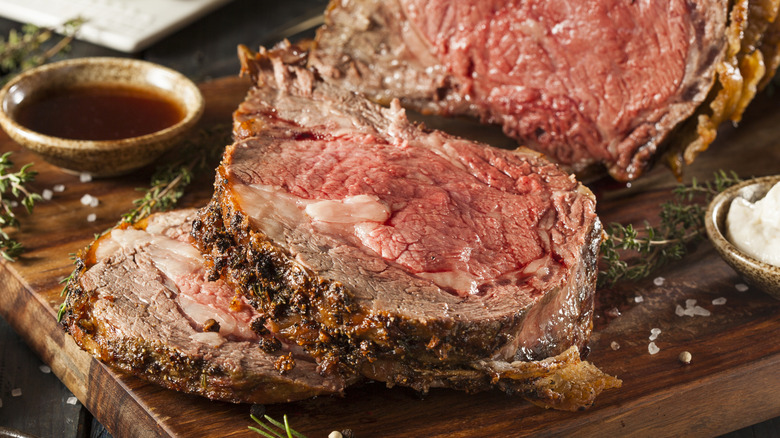How To Choose A Cut Of Prime Rib At The Grocery Store
Prime rib is one of those cuts of meat that many people associate with luxury, thanks to its tender, buttery texture and irresistible signature marbling. But that also means it's often a pricier cut, so picking one out at the grocery store can be intimidating. Fortunately, there are a few tips that should help you make a game-time decision. Like any culinary purchase, being an informed consumer can ensure you avoid missteps that lead to less than stellar experiences.
For one thing, it can be tough to gauge the difference between ribeye and prime rib — but keep in mind that most prime rib is designated as rib roast on the package. If you aren't totally sure of the meaning behind top beef grades, there are just three words you need to remember. When meat is marked with the word "Choice," it falls in the middle of the grading scale, has a decent amount of marbling, and tends to be what grocery stores keep on hand. "Prime" cuts will be highest on the quality spectrum (with the accompanying price tag), while "Select" come in on the low end, and will be the least juicy.
The basics for buying prime rib at the store
Another decision is whether you want the bone-in or boneless option. The former will offer a juicier finished product, while the latter is an easier-to-serve option since you don't have to worry about carving around the bone. When choosing a size, you can expect one pound to feed one guest (which equals roughly two guests per rib). If you happen to pick up too much meat though, you can easily reheat your prime rib so it's not dry and still packed with flavor.
You can rely on your senses for purchasing, too. Scope out the color, which should be a rich red, or border on purplish. If it's grayish, brown, or light red, there's a chance that it's oxidized and not as fresh. The marbling will also make a major difference in flavor, so you'll want a cut that has an even amount of fat throughout (which will ensure more uniform cooking). The meat shouldn't be super dry looking in the package, either. And if you touch it, there should be some elasticity to the texture.
Of course, when it doubt, it's a major help to simply ask your butcher for assistance. You can explain what you're looking for in terms of quality, fat distribution, the amount of guests you're planning to serve, and your cooking method, and then allow the expert to advise accordingly. Either way, armed with a little information, you can ensure your prime rib dinner will be one for the books.

